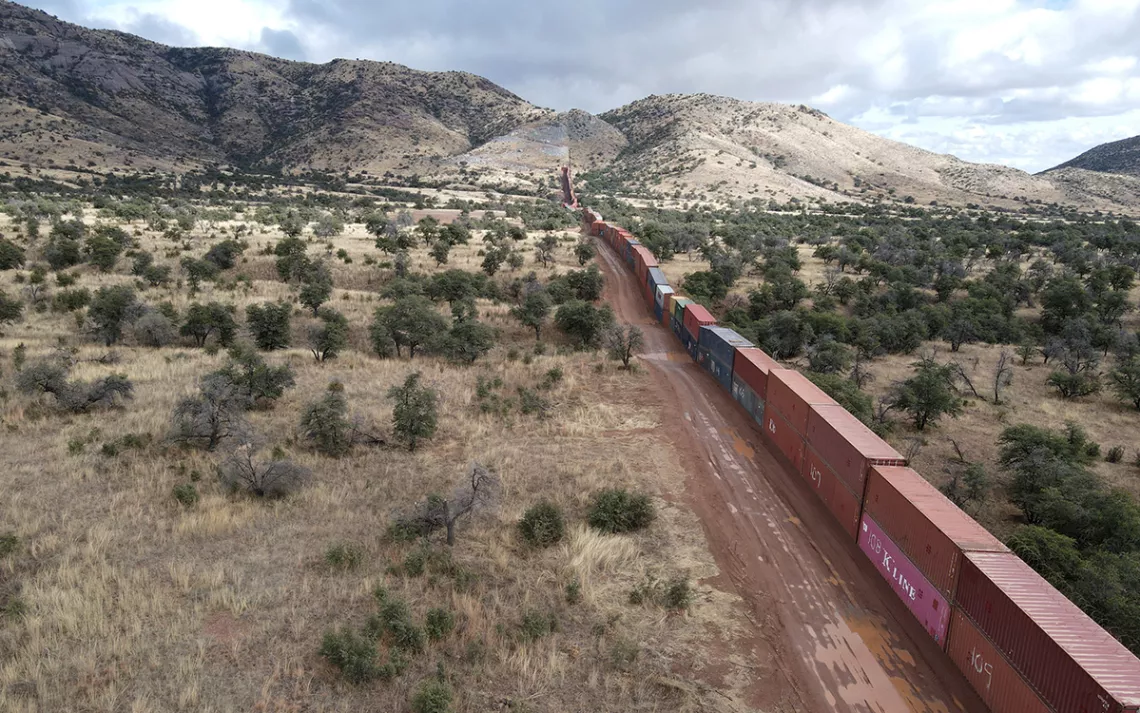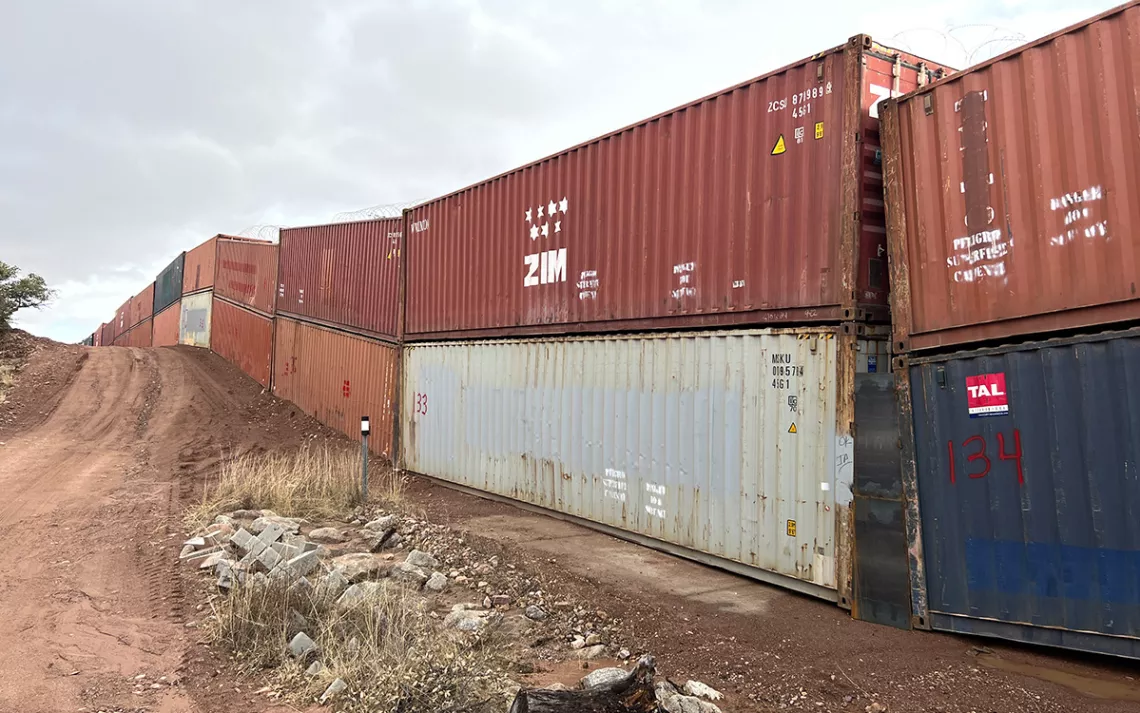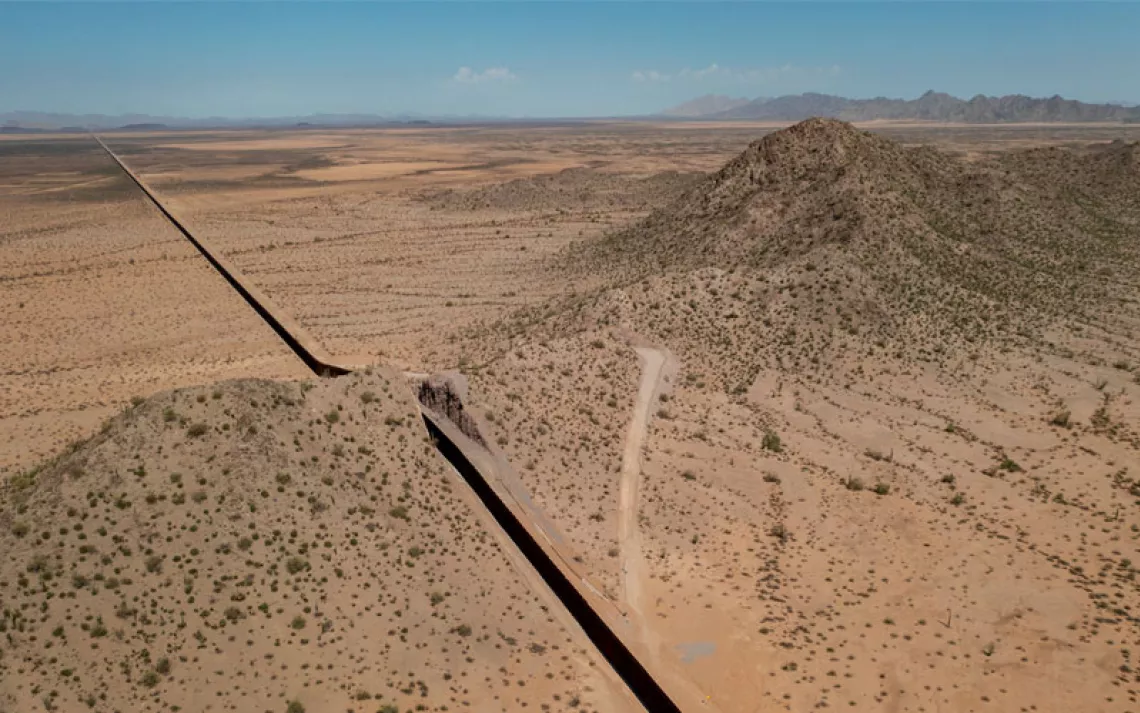How a Small Band of Environmentalists Stopped Former Arizona Governor Ducey’s Illegal Border Wall
The fight may be over, but Arizona taxpayers are still on the hook for Ducey’s stunt

Coronado National Forest shipping container wall. | Photos by Myles Traphagen/Wildlands Network
On August 12 of last year, Arizona’s then-governor, Republican Doug Ducey, began what some critics have called an insurrection against the United States.
Of course, that word isn’t found anywhere in Ducey’s Executive Order 2022-04. Instead, after the 37th “WHEREAS,” the governor’s THEREFORE announced his intention to “fill the gaps” in former President Trump’s border wall, including (and here’s the insurrection part) on federal land, where the state has no jurisdiction. Ducey ended his EO with a tough-guy flourish directed at the Feds: He authorized the Arizona National Guard to enforce his order if necessary.
Some thought the executive order was a political stunt, a bluff designed to get the Biden administration to fulfill its pledge to plug some still-unwalled sections in the most heavily crossed US-Mexico border areas in Arizona. It might have been a stunt—but it soon became clear it wasn’t a bluff.
A few hours after the executive order was issued, a convoy of giant excavators, military tactical trucks weighing nearly 20 tons, bulldozers, and cranes lumbered onto a strip of federal land managed by the US Bureau of Reclamation outside of Yuma, Arizona. Three months earlier, Ducey had quietly contracted with AshBritt, a scandal-plagued Florida disaster-response company, to build his makeshift border wall. Soon, AshBritt workers were double stacking dozens of old shipping containers, each 40 feet long and weighing nearly 9,000 pounds, and topping them off with razor wire.
The result looked less like an official border wall than the kind of barrier you might find at a junkyard. Only less stable. Three days after construction started, one of the stacks was discovered in the middle of the night lying on the ground, where it had nearly rolled into an irrigation canal. A Ducey spokesman claimed, without any evidence, that the collapse was an act of sabotage by enemies of the state. “We clearly struck a nerve,” spun C.J. Karamargin. Someone apparently doesn't like what we're doing.”
One community that didn’t like what Ducey was doing was the Cocopah Indian Tribe, a sovereign nation that has existed in the area on both sides of the border for centuries and whose reservation land abuts the container wall. Tribal officials complained to the governor’s office that the containers partially blocked a road used by the tribe for emergency vehicles and cut in two their binational community. The governor’s office refused to respond.
Some Arizona taxpayers also objected to the project’s price tag. Ducey claimed that the Yuma section cost $6 million. But when a copy of the contract with AshBritt leaked, the true cost turned out to be $12.6 million. People complained bitterly. What critics didn’t realize was that Yuma was just the beginning of Ducey’s plan.

*
In October, about two months after the container wall construction began, Russ McSpadden started to sense that something was afoot when he learned that hundreds of old shipping containers were showing up in the small town of Whetstone, Arizona, just outside of Coronado National Forest and some 240 miles southeast of the Yuma container wall. “I was shocked,” he recalled. “This is one of the wildest places in southern Arizona. Maybe even in the United States.”
Through his decade of work for the Center for Biological Diversity, McSpadden has developed a deep knowledge of the area. The border section of the Coronado, the San Rafael Valley, is that rare transitional zone where black bears and mountain lions share habit with neo-tropical species like the yellow-billed cuckoo, ocelots, and even jaguars, the only true “big cat” in the Americas. Much of the high-elevation native grasslands and oak woodlands had been designated as critical habitat for the endangered jaguar. Given its protected status, its location in a national forest, and the fact that the area had seen virtually no immigrant crossings, McSpadden had trouble believing that the shipping containers would end up there.
Just days later, however, AshBritt’s convoy of heavy equipment roared into the Coronado National Forest and began clearcutting and leveling a 10-mile-long stretch of federal land. Neither Ducey nor the company had permits for any of this, despite the fact that Coronado National Forest supervisor Kerwin Dewberry had sent state officials a letter on October 7 warning them that they must not proceed without permission from the Forest Service.
Kate Scott was out of town when she heard about the containers. Scott lives on a ranch in the Coronado National Forest, on land that includes critical jaguar habitat. She operates the Madrean Archipelago Wildlife Center, a nonprofit that she describes as a “MASH unit for injured raptors.” The center is just 15 miles north of where the container wall was going up.
When Scott returned in late November, she drove down to get a sense of the operation. What had been over three miles of gently rolling land was now denuded and graded flat. Century-old oak trees lay in piles, roots stretching into the dry air. Twenty-eight desert streams that fed the San Pedro, the Southwest’s last undammed river, had been blocked with fill-dirt and leveled. Hundreds of metal shipping containers ran across the landscape. From a distance, it looked like a freight train had been dropped into the wilderness. Scott was devastated. “It’s ecocide,” she told me, a legal term that the International Criminal Court is considering for adoption. “Ducey should be charged.”
Scott’s anger extends to the federal government for its failure to prevent the destruction. “It’s still a mystery to me,” she said. “Why didn’t they close it down when [Ducey] started?”
Scott realized that no federal cavalry would be riding to the rescue. “OK,” she decided. “We have to do something. We have to protest.”
Scott began organizing neighbors who were also outraged. When one neighbor expressed worries that they’d be arrested, Scott reminded them that they had every right to be there. It was Ducey and AshBritt who were breaking the law.
On the morning of November 29, Scott’s group showed up at the AshBritt building site and stretched a banner reading “Stop Ducey’s Illegal Destruction of Our Land, Water, and Wildlife,” across the road. The advocates blocked the enormous tactical trucks loaded with shipping containers—what Scott calls “Mad Max trucks," both for their fearsome appearance and for the excessive speed with which she says the workers drove them over narrow dirt roads.
The group was encouraged when work slowed down. They returned every day to block the road from 9 a.m. until 3 p.m., sometimes standing directly in front of machinery. One morning when Scott arrived, she saw several newly set up shipping containers. She realized they were working at night to evade protesters.
“That’s when we brought in our tents and sleeping bags and set up ‘Camp Ocelot,’” Scott said.
Despite some tense stand-offs, no new shipping containers went up for several days. On the night of December 8, a few protesters were sitting around a small campfire talking. During a lull in the conversation, something occurred to Scott. “I don’t know about you guys,” she told to the group, “but I think we won.”
The next day, a construction supervisor walked up to the protesters and asked them not to get in their way. “We don’t want you to sit in the road,” he said. It seemed like an odd request. When had they wanted the protesters to sit in the road? This was different, he explained. They now needed access to the road because they were going to remove all 962 shipping containers.
“And so it turned out to be true that that had been our day,” said Scott. “We had won. We'd truly stopped it.”

*
On paper, Ducey’s stunt ended on December 21 with a formal agreement filed in US District Court. Ducey agreed to cease all activity on federal lands and remove the shipping containers by, “to the extent feasible,” January 4, 2023—which happened to be just two days after Ducey would be out of office, replaced by Democrat Katie Hobbs. During her campaign, Hobbs had pledged to stop building the container wall. Now, Governor Hobbs was obligated to complete the removal of the wall left by her predecessor, thanks to the binding agreement Ducey signed. Perhaps that was on her mind on January 9 when she delivered her first State of the State address, observing that “immigration has been politicized for far too long. Arizona voters … don’t want or need political stunts.”
So far, Arizona taxpayers have paid $200 million for a political stunt with not much to show for it. The final cost won’t be known for years, however. Myles Traphagen, a biologist specializing in borderlands issues for the group Wildlands Network, said that in addition to the cost of remediating damaged federal land and roads, the state will need to monitor the scarred area for invasive species.
“Whenever you bring heavy equipment into an area with disturbed, bare soil, you run the risk of bringing in a lot of nonnative weeds,” he explained. The cost of not funding a monitoring program could be even larger. Many invasive plants are poisonous to livestock and pose an existential threat to an area still largely reliant on ranching. Clearing out invasive plants can also be time-consuming and expensive. (Traphagen’s map, monitoring construction and removal of the wall, is online.)
Kat Rodriguez points to an even larger cost: to people. As a longtime border justice advocate, Rodriguez is all too familiar with the suffering caused by elected officials—at all levels—who favor stunts over substance in the borderlands. Small-town hospitals have been overwhelmed treating migrants who are dehydrated or have broken bones. Thousands of desperate people fleeing violence in their home countries have died attempting to cross the Arizona desert. Rodriguez calls Ducey’s wall just another in a long line of “mirages”—projects designed by politicians to trick mostly white voters into believing they’ll be safer from brown and Black “invaders.”
“It’s all part of demonizing human beings for political ends,” she says. “It’s using people to create a strongman image.”
She knows another phrase, this one in Spanglish, that sums up the saga of Ducey’s now-it’s-up, now-it’s-down wall.
“Es puro show,” she says in a voice that is both angry and exhausted. “It’s pure show.”
 The Magazine of The Sierra Club
The Magazine of The Sierra Club



